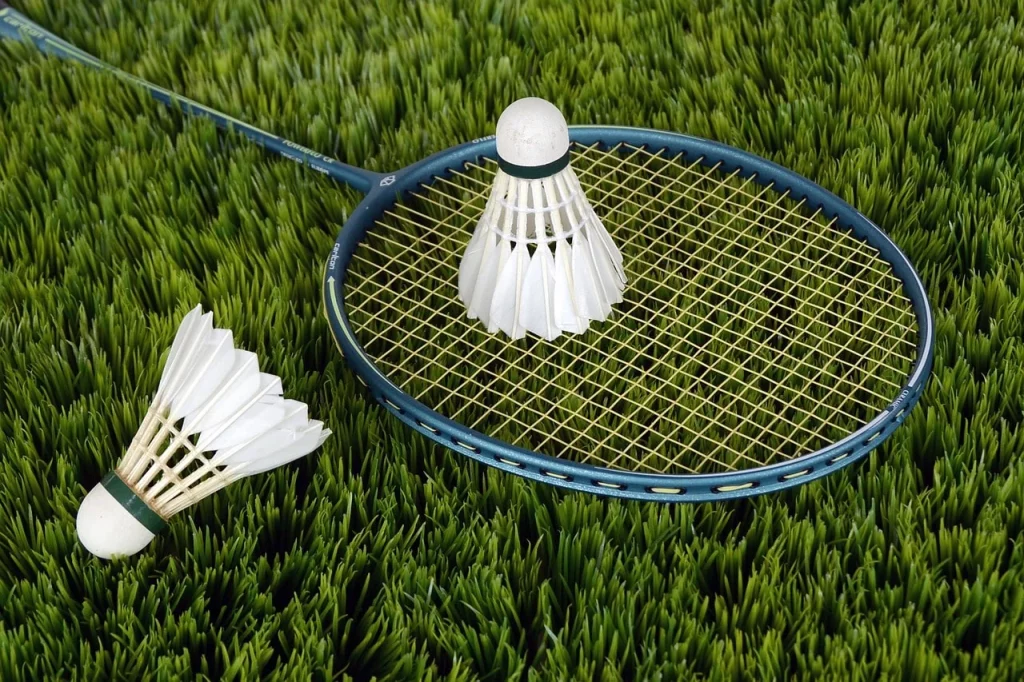Have you ever wondered what makes badminton more than just a backyard sport? Welcome to a world where speed and strategy blend seamlessly, a world of feathered shuttles and lightning-fast reflexes.
Badminton, a sport enjoyed by millions worldwide, is full of surprises and hidden depths. In this journey through these fascinating facts, we’ll explore the high-flying dynamics, the rich history, and the global passion that transform badminton into an exhilarating spectacle. So, grab your racket, and let’s dive into the amazing universe of badminton!
Badminton is not only about winning. What’s important to me is about playing hard, doing my best, and putting up a good show for the spectators.
Lin Dan
Badminton Facts
Let’s start our journey into the fascinating world of badminton. Read carefully, because I created a quiz for you at the end of the article. It’s your time to prove you are a master on the topic. Don’t disappoint me.
- Poona, in India, was where badminton evolved from a game called ‘Battledore and Shuttlecock’.
- Badminton became an Olympic sport in 1992, during the Barcelona Olympics.
- The fastest recorded badminton smash was 493 km/h (306 mph) by Mads Pieler Kolding.
- Badminton shuttles are made from the left-wing feathers of a goose.
- The shortest badminton match ever was just 6 minutes long.
- Badminton is the second most popular sport in the world, after soccer.
- A badminton match consists of the best of 3 games of 21 points each.
- The strings of a badminton racket are made from the intestines of cats or cows.
- Denmark is the most successful European badminton nation.
- Badminton’s original name was ‘Poona’, after the Indian city where it was popularized.
- The International Badminton Federation (IBF) was founded in 1934.
- China has won over 300 Olympic and World Championship medals in badminton.
- Badminton rackets used to be made of wood, which made them heavy.

- The longest badminton rally lasted 256 shots.
- Badminton requires a player to have excellent fitness levels, including agility and endurance.
- The All England Open was first held in 1899 and is one of the oldest badminton tournaments.
- Badminton was initially played with woollen balls in medieval times.
- In the 16th century, badminton was known as ‘Jeu de Volant’ in Europe.
- Indonesia and Malaysia are powerhouses in international badminton competitions.
- Badminton shuttles can travel more than 200 mph.
- A badminton court measures 13.4 meters in length and 6.1 meters in width for doubles matches.
- The term ‘love’ in badminton scoring means zero or no score.
- Badminton players can cover more than 6 kilometers in a single match.
- The original badminton rules were drawn up in 1873.
- A typical badminton feather shuttlecock has 16 feathers.
- Badminton was first played in the USA in 1878.
- The BWF World Championships are held every year, except for Olympic years.
- Kento Momota, a Japanese player, is known for his incredible comebacks after serious injuries.

- Badminton is often played outdoors as a casual recreational activity.
- The net in badminton is 1.55 meters high at the edges and 1.524 meters in the center.
- Badminton footwork is crucial for effective gameplay and involves complex movements.
- In professional badminton, the most common injuries are ankle sprains.
- Lee Chong Wei of Malaysia was ranked world No. 1 for 199 consecutive weeks.
- Professional badminton players change their racket grip frequently, sometimes every match.
- The Thomas Cup, for men’s teams, was first held in 1948-49.
- Women’s badminton teams compete for the Uber Cup, established in 1956.
- A badminton shuttlecock can have a speed of over 400 km/h at the moment of impact.
- The lightest badminton rackets weigh around 70 grams.

- Badminton was played in the Commonwealth Games for the first time in 1966.
- The ‘Deception Shot’ in badminton is a sneaky way to mislead the opponent.
- A ‘Clear’ is a basic badminton stroke, used to push the shuttle deep into the opponent’s court.
- Badminton shoes are designed to provide good grip and support on court surfaces.
- In professional badminton, carbon fiber is commonly used for racket construction.
- The Sudirman Cup is the world mixed team badminton championship, held every two years.
- A badminton serve must be executed below waist level.
- The ‘Flick Serve’ in badminton is an unexpected move to catch the opponent off guard.
- Badminton requires strategic thinking and quick decision-making skills.
- The Badminton World Federation (BWF) is the sport’s international governing body.
- A ‘Drop Shot’ in badminton is designed to fall rapidly and land close to the net on the opponent’s side.
- Badminton strategies often involve exploiting the opponent’s weaknesses.
Badminton Myths

Having explored all these fun facts about badminton, let’s now delve into separating myths from reality. Prepare to challenge what you think you know about this dynamic sport.
- Badminton is an Easy, Low-Energy Game
Often perceived as leisurely, badminton is actually a high-intensity sport requiring stamina, speed, and precision. Elite players can smash the shuttlecock at speeds over 200 mph, and matches can last for hours, demanding intense physical and mental endurance. - Badminton is Mostly Played Indoors
While competitive badminton is primarily an indoor sport to avoid wind interference, it’s widely enjoyed outdoors too. Casual games in parks and backyards are common, demonstrating the sport’s versatility and widespread appeal in various environments. - Badminton Doesn’t Require Much Physical Strength
Contrary to this belief, badminton players need significant physical strength, especially in the wrists and legs. The sport involves explosive movements, quick reflexes, and endurance, requiring a high level of fitness and muscular strength to perform effectively. - Badminton Equipment is All Similar
There’s a vast range of badminton equipment tailored to different playing styles and levels. Rackets vary in weight, balance, and string tension, while shuttlecocks can be made from different materials affecting flight and speed, highlighting the sport’s complexity and precision. - Badminton is a Relatively New Sport
Badminton has a rich history, with its roots tracing back centuries. It evolved from earlier games like battledore and shuttlecock. The modern version of the sport was developed in England during the 19th century, making it a sport with a deep and diverse history.
No products found.
Badminton Quotes

Badminton, more than just a backyard sport, holds a special place in the hearts of many. Here, I present a collection of my favorite quotes that encapsulate the excitement and finesse of it.
When you are playing badminton there are only two possibilities – either you win or you learn.
Taufik Hidayat
Taufik Hidayat, an Indonesian badminton icon, highlights the dual outcomes of playing badminton: winning or gaining valuable experience.
Talent wins games, but teamwork and intelligence win championships.
Mia Audina
Mia Audina, a prominent figure in Dutch and Indonesian badminton, underscores the significance of teamwork and intellect in achieving great success.
I’m just an athlete who loves to play badminton.
Saina Nehwal
Saina Nehwal, an Indian badminton star, expresses her simple yet profound passion for the game.
The art of badminton is to deceive.
Morten Frost
Morten Frost, a Danish badminton legend, captures the essence of badminton as a game of strategy and deception.
Badminton will make you sweat but it will also teach you the art of precision.
Peter Gade
Peter Gade, a renowned Danish badminton player, speaks to the balance of physical exertion and precision required in badminton.
Badminton FAQ

You’ve just absorbed wisdom from badminton’s finest. Now, gear up for the last section before the quiz: the FAQs. Every detail matters, so read with care.
- How was badminton invented?
Badminton has its roots in ancient games, but it evolved into its modern form in the mid-19th century among British military officers stationed in India. The game was likely inspired by an Indian game called “poona.” British officers took the game back to England, where it became popular at a party hosted in 1873 at Badminton House, Gloucestershire, owned by the Duke of Beaufort. From there, the name “badminton” was adopted, and the rules were standardized. - Are badminton and volleyball nets the same?
No, badminton and volleyball nets differ significantly. A badminton net is typically 5 feet 1 inch (1.55 meters) high at the edges and 5 feet (1.524 meters) high in the center. In contrast, a volleyball net is taller, standing at approximately 7 feet 11 5/8 inches (2.43 meters) for men’s competition and 7 feet 4 1/8 inches (2.24 meters) for women’s competition. - What is the standard court size for badminton?
A standard badminton court is rectangular and measures 44 feet (13.4 meters) long and 20 feet (6.1 meters) wide for doubles matches. For singles matches, the width is reduced to 17 feet (5.18 meters). The court is marked with lines that delineate the service courts, doubles sidelines, and back boundaries. - What are the basic rules of scoring in badminton?
Badminton matches are typically played as best of three games. To win a game, a player or pair must score 21 points with a margin of at least two points over the opponent. If the score reaches 20-20, the game continues until a two-point lead is achieved, up to a maximum of 30 points. Points can be scored on either player’s serve, contrasting with older rules where points could only be scored on one’s own serve. - Can badminton be played outdoors?
While traditionally an indoor sport to avoid interference from the wind, badminton can be played outdoors for recreational purposes. There are even variations like beach badminton. However, professional matches and tournaments are generally held indoors to maintain consistent playing conditions.
No products found.
Badminton Quiz

Welcome to our badminton quiz! Remember, if you don’t get at least one answer right, you might just find yourself being used as a shuttlecock in our next game!
Conclusion
Diving into the world of badminton reveals a universe where precision meets endurance. Each fact we’ve explored highlights not just the complexity of the sport but also the dedication of its players.
From the swiftness of a shuttlecock to the diversity of playing styles across continents, badminton is a testament to human excellence and adaptability. As always, let’s close this with a funny question: If you were a badminton superhero, what unique power derived from the sport would you choose to have? Let me know in the comments.
6 Sources Used For This ArticleAbout The Game – Badminton
Is badminton the oldest racket sport? – Play It On Grass
Badminton Questions and Answers – The Uk Rules
Badminton vs Tennis – Tennis Adrenaline
Badminton – Las Princesas Del Badminton


